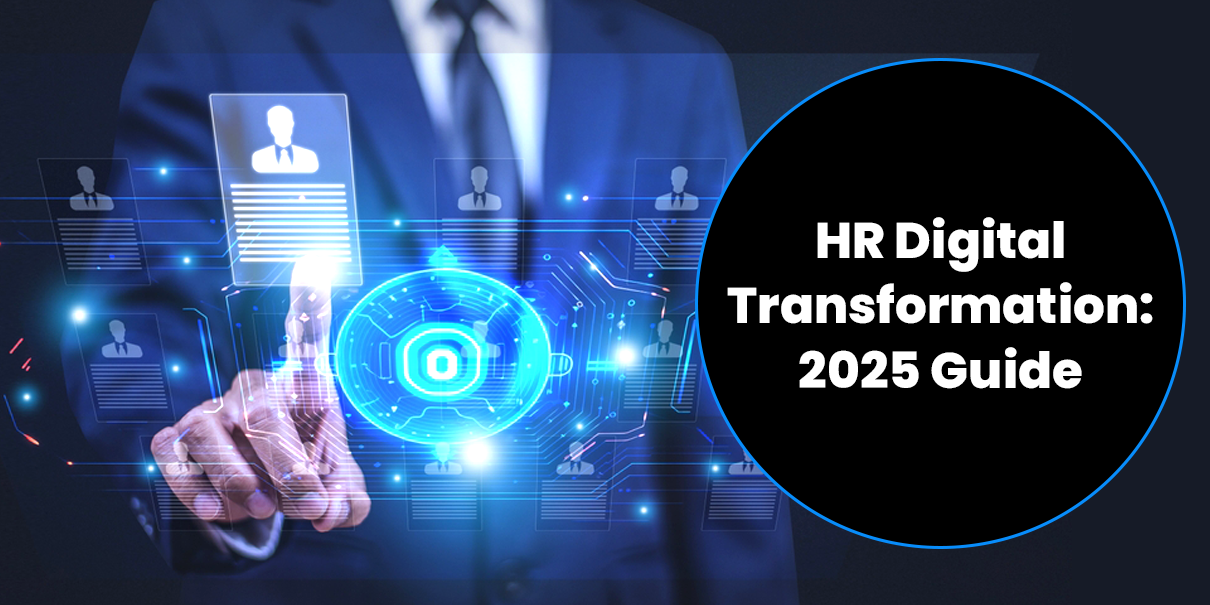The most valuable resource in any company is the people who work there. Proper recruitment, strategic staffing, and empathetic people management help lay the foundation for businesses to build nearly every successful workflow. Because human resources and talent acquisition teams handle vast amounts of information every day, increasing their capacity for accuracy and efficiency in these routine tasks can improve the life of every employee in an organization.
HR Digital Transformation is one of the leading strategies many companies are embracing to modernize their HR and recruitment processes. While digitization — the practice of moving resources and tasks to an online platform — is fairly ubiquitous now, digital transformation (DX) refers to a ground-up transformation of HR processes using cutting-edge digital tools.
To further clarify, we’ll discuss some of the topics we expect to increase in popularity for 2025, including:
- HR Digital Transformation trends going into 2025
- How we expect HR Digital Transformation to evolve
- The best HR Digital Trasformation strategy
Let’s dive into each subject individually to get a better understanding of the HR Digital Transformation landscape.
Existing HR Digital Transformation Trends
Understanding what steps other businesses are taking to effect their own HR Digital Transformations provides an essential baseline for comparing innovations in the coming year. For businesses at the start of the DX process, these examples also offer reference points for how to begin.
The HR clients we work with have helped us highlight some of the following DX trends:
| Trend | Description |
|---|---|
| Data Automation | One of the most common trends among our Digital Transformation clients is a focus on automating data workloads. HR presents many opportunities for automation, such as capturing data from documents, organizing it, and generating reports. |
| Better Employee Training | Digital Transformation improves staff training by providing wider and more accessible libraries of on-demand education resources. |
| AI Recruiting Assistance | Implementing AI in recruiting processes accelerates the process of sifting through candidates and increasing the complexity of automated sorting criteria accounts for blanket disqualifiers that might otherwise exclude the quality talent you need. |
| Simple Onboarding With Automation | HR software platforms can simplify employee onboarding with automations for different job titles, complete with integrations for project management platforms, automatic account creation, and custom-tailored training curricula. |
| Deeper Analytics | Data automation and other tools included in cutting-edge HR platforms can automatically generate reports and key analytics to give leadership teams clearer insights into improving people management. |
These examples provide a great overview of Digital Transformation as it exists for most HR departments right now. Simply implementing the five trends above can elevate most businesses to a level that justifies the investment. However, the coming years promise much more to come as AI and machine learning (ML) technology continue to improve. As The Wall Street Journal reports, 80% of 400 surveyed corporate officials expect AI to influence HR and recruiting over the next year.
How We Expect HR Digital Transformation To Evolve
Increased technological advancements and a tighter focus on company alignment have prompted some new interests among our clients, and we expect these factors to affect Digital Transformation across industries, as well. As a result, increasing numbers of Digital Transformation clients are looking for the following features in their HR software platforms:
| Feature | Benefits |
|---|---|
| Omnichannel Functionality | Businesses want their software platforms to offer the same capabilities on smartphones and tablets as they do on desktop or laptop computers. This is especially important for brands with employees that frequently use multiple devices. |
| Inter-Department Unification | Unifying data assets presents one of the most significant potential use cases for AI and ML-powered platforms. AI integrations can help create a single source of truth for a single company’s multiple departments while also allowing enough separation to manage workflows. This enables companies to leverage only a few operational platforms and establishes a more direct connection between HR and related departments. |
| Generative AI Applications | Generative AI can be used to draft emails, contracts, and training materials based on company-set criteria for faster recruiting and onboarding processes. As the technology becomes more sophisticated, the content created by AI will improve in quality and consistency. |
While these aren’t the only stand-out examples we expect to see in HR’s ongoing digital evolution, they seem to be the most popular implementations among firms that want to see the best results from AI/ML platforms commonly associated with Digital Transformation. Organizations that want to start a DX journey today and stay ahead of the curve will want to consider tools that leverage these three primary features.
| Download our white paper:
How To Prepare Data for an Artificial Intelligence Development Project |
The Best HR Digital Transformation Strategy
Typically, choosing the best Digital Transformation implementation strategy requires a thorough review of your business goals to determine your specific needs. This in turn enables you to make a strategic evaluation of all the available software providers, developers, and consultants that specialize in exactly the type of tool(s) you need.
There are two primary paths you can take to initiate your DX implementation:
- Third-Party Out-of-the-Box Software.
Purchase multiple out-of-the-box (OOTB) software tools to transform different aspects of your business and rely on a few different providers for software and training materials. - Third-Party Custom Software.
Hire a custom software developerto assess your needs, create bespoke software tailored to your processes/goals, and provide training materials for your staff.
We recommend the second strategic option because choosing a custom developer provides you with custom solutions, access to top-notch talent, and full technical and training support.
Third-Party Out-of-the-Box Software
| Pros | Cons |
|---|---|
| ✔ Cheap | ✘ Generic, limited feature sets |
| ✔ Easy to train staff | ✘ Work with multiple providers and timelines |
| ✔ Relatively bug-free | ✘ Expensive to add features |
The least expensive option is to purchase multiple out-of-the-box software tools, but remember the old saying: you get what you pay for.
Aside from the obvious – immediate availability and lower costs – these tools offer few advantages. Because they’re marketed to multiple companies, they tend to be relatively bug-free and have dedicated bug-fixing teams, as well as comprehensive on-demand libraries of user training content.
Beyond these benefits, however, OOTB tools can be troublesome, costing you more than just money. Firms striving to meet operational goals across departments may grow frustrated from dealing with multiple service providers, and their individual timelines and processes.
By definition, such general-purpose tools are never custom-tailored to your goals. In the pursuit of a truly valuable end product, many businesses find they’re getting nickel-and-dimed for “extra” (often unnecessary) features. This kind of situation really makes Warren Buffett’s famous words resonate: “Price is what you pay. Value is what you get.” Too often, hidden costs like time and aggravation outweigh the savings of “budget-friendly” software solutions.
As a result, we can only recommend this option for firms with a single, simple goal, such as adding chatbot functionality to a website, simplifying payment processing on a shop page, or other similar use cases.
Third-Party Custom Software
| Pros | Cons |
|---|---|
| ✔ Custom-tailored solutions | ✘ More expensive than OOTB software devs |
| ✔ Top-tier development talent | ✘ Development staff aren’t in-house |
| ✔ Accessible training and support | |
| ✔ Full onboarding assistance |
Hiring a custom software developer delivers maximum value by combining the convenience of in-house staff with the benefits of third-party developers. A quality custom dev will do a deep dive into your business to understand its processes, your unique pain points, and other Digital Transformation opportunities.
An expert dev team works with your company to create and deploy premium software with cutting-edge technology. They usually staff exceptional talent because they specialize in creating purpose-driven tools for niche industries. They also have more available staff for training and user support since they frequently onboard new tools for businesses of all sizes.
The drawbacks include a higher price tag than OOTB software, and you don’t get the benefit of having your own in-house developers. High-quality custom developers like 7T work to alleviate these drawbacks by providing quick, comprehensive support, along with enough value to ensure your Digital Transformation always generates more than enough income to negate the cost.
Implement HR Digital Transformation With 7T
At 7T, we use a problem → solution approach to create AI/ML solutions for our clients across countless HR departments and recruiting firms. Through our custom-built platforms, machine learning and AI technology can provide significant operational advantages with a robust ROI. Our team will audit your organization’s challenges, often by showing up on-location for a time to embed ourselves within your business and understand your needs from a first-person perspective. Then, we’ll architect a value-generating solution to transform your vital processes and meet your goals.
7T is based in Dallas, Houston and Charlotte, NC, but our clientele spans the globe. If you’re ready to learn more about HR digital transformation, contact 7T today.










